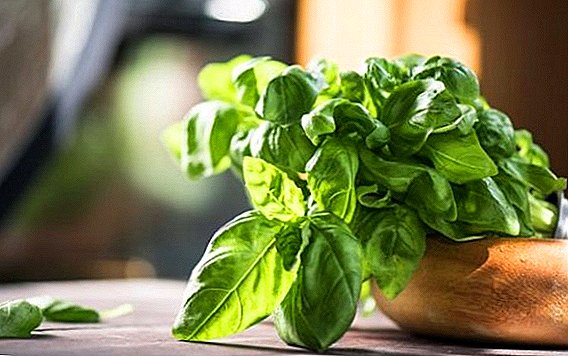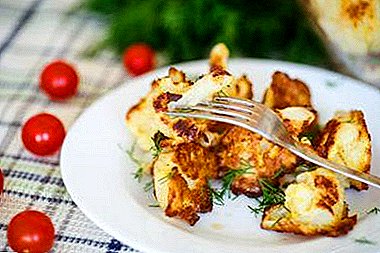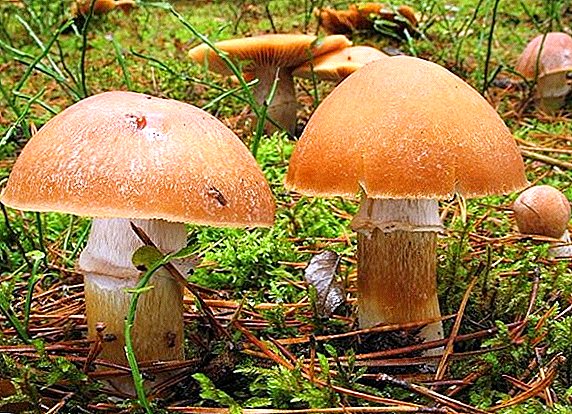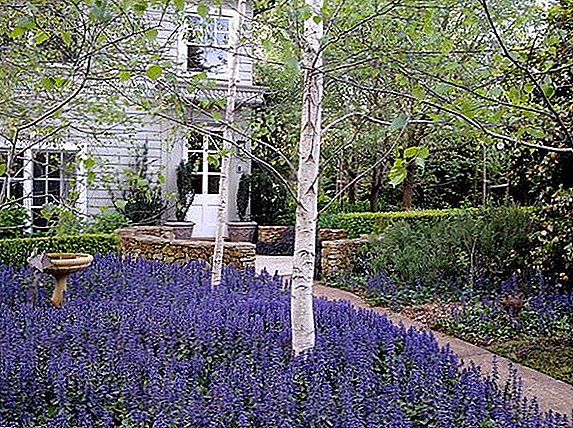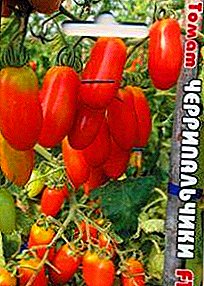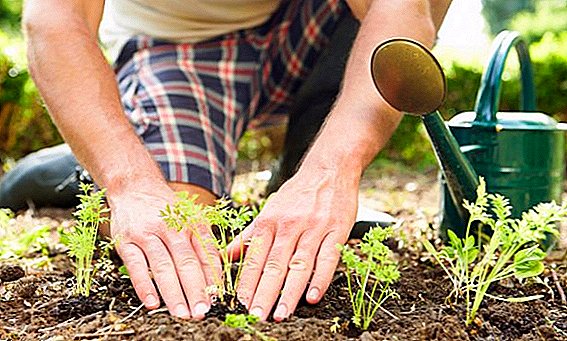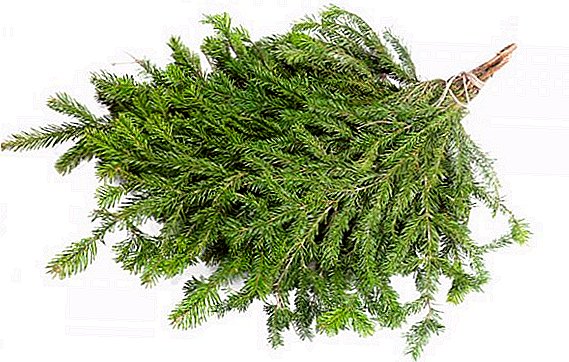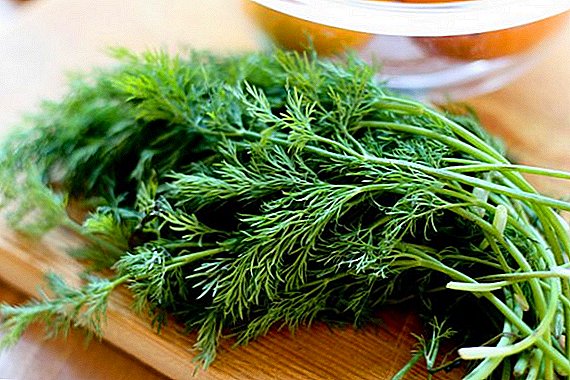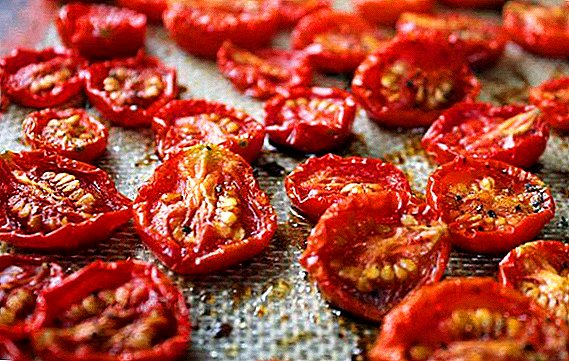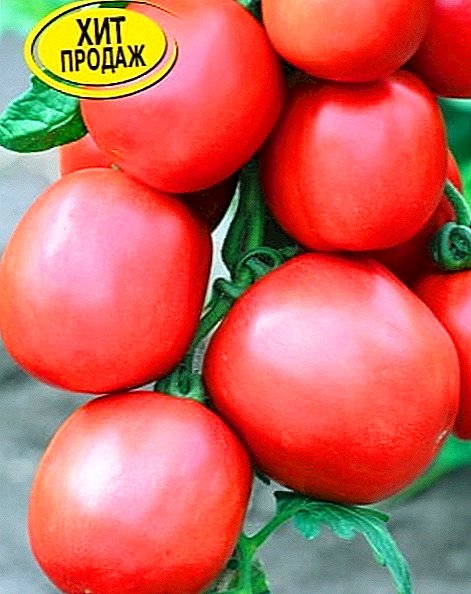 In search of new varieties of tomatoes, domestic gardeners and gardeners are increasingly beginning to give preference to the newly bred Stolypin variety.
In search of new varieties of tomatoes, domestic gardeners and gardeners are increasingly beginning to give preference to the newly bred Stolypin variety.
This variety of tomatoes has proved itself only from the best side: excellent yield, high taste qualities of fruits, resistance to rapid temperature changes.
In this article we will provide a description and the main characteristics of the variety, as well as provide data on the proper agricultural practices of cultivation.
Appearance and description of the variety
The variety has beautiful and tasty fruits, the merits of which are noted by many gardeners. Tomato "Stolypin" was bred recently in the territory of Russia and since then has won the trust of many summer residents.
This tomato is a hybrid, that is, a determinant. The bush of this hybrid is actively growing until the beginning of the formation of the first brushes. Side shoots grow for a long time, so the bushes need to crape.
The inflorescences on the bushes are simple, have stalks on the joints. The plant grows to 60-75 cm in height, while its diameter reaches the same size.  From the beginning of the sowing of seeds to ripening of the first fruits, it takes 90-100 days, therefore the variety is considered medium early.
From the beginning of the sowing of seeds to ripening of the first fruits, it takes 90-100 days, therefore the variety is considered medium early.
Fruit Characteristic
The fruits have an oval-elliptical shape. At the stage of maturation painted in bright green. When the tomatoes are fully ripened, their flesh and skin become red and pink.
The skin itself is dense and cracks only with improper care for plantings (excessive humidity, frequent watering, etc.).
Fruits are distinguished by an average indicator of the presence of dry substances in the composition; however, they are also fragrant, juicy, and have a slight sweet taste.
Check out such varieties of tomatoes as Chio-Chio-San, Tolstoy f1, Lyubasha, Ox-Heart, Pink Stella, Sugar Pudovik, Lazyka, Torbay F1, Olesya "," Bokele F1 ".
With proper care, the skin does not crack, so the fruit can be stored for a long time. Tomatoes "Stolypin" are suitable for fresh salads, preservation, as well as a variety of hot dishes. 
The advantages and disadvantages of the variety
The main advantages of tomato varieties "Stolypin" are:
- resistance to low temperatures in the summer. Shrubs are able to grow normally and tie new fruits even with recurrent night frosts. That is why the variety is highly valued in the northern regions, as well as in the regions of high-risk agriculture;
- suitable for planting, both in open ground and in greenhouses, greenhouses;
- high yield. If all the rules and subtleties of agrotechnology are observed, from one bush of tomato cultivar "Stolypin" it is possible to collect from 7 to 10 kg of fruits;
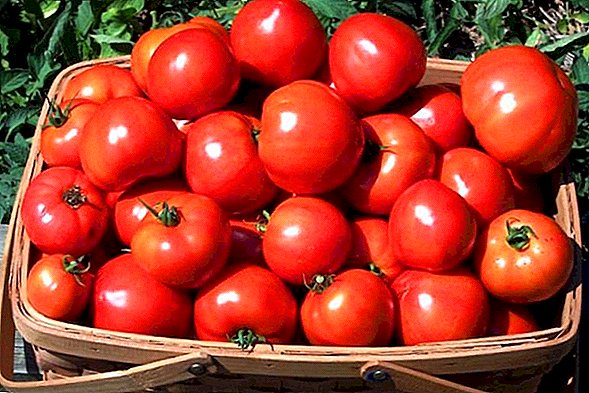
- small seed nest with a small number of seeds. This makes the fruit more fleshy and dense. In addition, they are quite large in size: fruits can reach a weight of 150 g;
- good portability of transportation and long storage period;
- excellent taste of the fruit, allowing them to be used in absolutely any culinary dishes;
- high resistance to diseases and pests.
Unlike the merits, the Stolypin tomatoes have practically no disadvantages. One of the negative aspects of the variety can be considered poor resistance to high air temperatures (at temperatures above +30 ° C, the flowers on the bush remain sterile and poorly tied).
At elevated humidity, tomatoes can be affected by vertex rot.
The average height of the bush bush can hardly be considered a disadvantage, however, some gardeners still consider it a negative quality because of the need to spend time on the garter.  But it should be noted that the bush reaches a height of only 60-70 cm, and this is much less than many other varieties of tomatoes (for example, the Bear Paw variety reaches a height of two meters or more).
But it should be noted that the bush reaches a height of only 60-70 cm, and this is much less than many other varieties of tomatoes (for example, the Bear Paw variety reaches a height of two meters or more).
Agrotechnology
The quality and quantity of fruits will depend on the agro-technology of growing Stolypin tomatoes. To get tomatoes of ideal shape, with a pleasant sweet taste, you must follow all the rules, which we describe below.
Seed preparation, planting seeds and care for them
Before planting the seeds must be properly prepared and hardened. At the very beginning, the seed material is placed in a fabric bag and dipped into a 15-20% aqueous solution of potassium permanganate.
This procedure will help protect future plants from viral diseases, as well as contribute to friendly seedling. Then the seeds should be placed for 24 hours in an aqueous solution of wood ash (for 1 liter of water 1 tsp. Of ash).
The quenching stage follows: a bag of seeds is placed in a refrigerator and held there for 1-2 days (in this mode, the seed should be periodically sprayed with water).  Seeds of tomato varieties "Stolypin" are often planted from mid-February to early April. Such a wide interval is explained by the diversity of climatic zones of growth.
Seeds of tomato varieties "Stolypin" are often planted from mid-February to early April. Such a wide interval is explained by the diversity of climatic zones of growth.
In the southern regions of Ukraine and Russia, seedlings can be planted as early as the twentieth of February. In the central regions of Russia, the central and northern regions of Ukraine, and also in the southern part of Belarus, the seeds are planted throughout March (depending on how quickly the winter frosts leave the region).
In the northern regions of Russia, tomato seedlings are planted in early April, since transplantation into open ground will occur in early summer.
For planting seed, it is necessary to prepare containers and soil in advance. Capacities for planting can be bought in specialized stores, or you can make one yourself from disposable cups (after punching a few holes at the bottom).
An ideal soil for seedlings of the Stolypin variety will be a mixture of peat, river sand, humus and wood ash (the latter is added to reduce acidity). The first three components are taken in proportions of 2: 2: 1, wood ash is applied in the amount of 1 cup per 5 kg of soil.
Seeds are planted 1-2 cm deep. If landing is done in boxes, it means that a further dive procedure is implied.
When planting in boxes it is necessary to observe the distance between the landings: 2 cm in a row and 3-4 cm between rows. After planting, the boxes or cups are covered with a film (it can be glass) and put in a warm place (the optimum temperature for fast germination is + 25 ° C).
Under ideal conditions of detention after the first 7-9 days should appear the first sunrises.
As soon as the seedlings begin to break through, the film or glass is removed. Now they need long-term illumination, so many gardeners recommend using special lamps (tomatoes need 14-16 hours of daylight).
Water the seedlings need moderately and not too hard. It is believed that before the appearance of the first leaves, watering is generally not necessary, and then they are held only once a week. Water flows until it begins to flow from the lower holes of the containers with seedlings. 
Did you know? Doctors say that regular consumption of tomatoes in any form (ketchups, sauces, salads, juices, etc.) significantly reduces the risk of cancer.
The pick is needed to strengthen the root system of the tomato bushes. It is best to transplant the seedlings one by one into half-liter peat cups.
The soil for transplanting must be prepared using the previous formula. The main thing to remember is that the Stolypin tomato dive should be started with the appearance of the third true leaf.
Seedling and planting in the ground
The entire seedling period, tomatoes must be regularly watered and illuminated. Periodically the soil will need loosening. The seedling period of tomato varieties "Stolypin" should take 60-75 days.
During this time, crops need to be fed 2-3 times with mineral and organic fertilizers. For dressing it is necessary to use complexes that contain potassium, phosphorus and nitrogenous compounds in equal proportions.
However, it is necessary to take into account the fact that sometimes there is an overabundance or shortage of one or another macro- / microelement in the soil with crops.  For example, if there are purple streaks on the underside of the leaf, it means that the seedlings need to be fed with phosphate fertilizers, and if the leaves begin to turn yellow, it means that there are not enough nitrogen elements in the soil.
For example, if there are purple streaks on the underside of the leaf, it means that the seedlings need to be fed with phosphate fertilizers, and if the leaves begin to turn yellow, it means that there are not enough nitrogen elements in the soil.
Potassium deficiency is better identified at the seedling age, as it may further adversely affect the process of fruit ripening.
If young shoots begin to wrinkle the leaves, then this is the first sign of a lack of potassium in the soil. The seedlings, which are kept around the clock in a lighted room, can get sick with chlorosis (we said that we need to light the shoots no more than 16 hours a day).
In plants with chlorosis, there is a lack of iron. In such cases, treatment should be carried out using a hypotonic solution.
Technically correct feeding is not the only key to success in growing tomatoes. In addition, the seedlings still need to harden, properly transplanted and provide competent care until the fruit ripens.
In most cases, Stolypin tomatoes are used for planting in open ground, so they need hardening, which is produced by the method of gradually reducing the temperature in the room.  A few days before disembarking, seedlings are exposed under the open sky, and in 1-2 days it can be left for the whole night.
A few days before disembarking, seedlings are exposed under the open sky, and in 1-2 days it can be left for the whole night.
Important! Tomatoes are forbidden to be planted at the place of growth of potatoes or tobacco, as there is a risk of these plants being affected by the same diseases.
When at least 60 days have passed since the seedlings have been planted on the seedlings, dive or non-pickled plants can be transplanted. The site, well lit and protected from gusty winds, will become an ideal place for landing.
The best precursors for tomatoes are legumes, cabbage and pumpkin. Before planting, the soil must be composted or humus.
The holes for planting are made to the full depth of the peat cup, while leaving small wells for watering. The following can be considered an ideal landing pattern: on a plot, draw squares with sides of 1 m (they should have common sides); Plant tomato seedlings on each corner of the squares. Immediately after planting, at least 5 liters of warm water should be poured out under each of the bushes.
Did you know? Two glasses of pure natural tomato juice contain the entire daily human need for vitamin C.
Care and watering
Technically correct care for Stolypin varieties of tomatoes implies regular limited watering. They are produced moderately and only when the soil dries out a little.
Watering is better to produce under the root, and then slightly loosen the soil. If you moisten the tomatoes by sprinkling, this can lead to the appearance of various fungal diseases.
Loosening is carried out 3-5 times during the whole growing season of tomatoes. The first time the soil should be loosened to a depth of 10-12 cm, all subsequent times - by 3-5 cm.
Such procedures will not allow the crust to form and be compacted to the top layer of soil. In addition, in moments of loosening do not forget to remove all excess weed from the beds.  The variety of tomatoes "Stolypin" is distinguished by the average height of the bush, but it needs a garter. Tied bushes are much easier to take care of, moreover, their stems will not break under the weight of the fruit.
The variety of tomatoes "Stolypin" is distinguished by the average height of the bush, but it needs a garter. Tied bushes are much easier to take care of, moreover, their stems will not break under the weight of the fruit.
For example, old tights, stockings, sheets can be used as a garter. They are cut into strips, the width of which should be at least 3 cm. As a support, it is best to use wooden stakes.
They dig into the ground to a depth of 30-40 cm, the height above the ground should be at least 1 meter (remember that the bushes of tomatoes, "Stolypin" can grow up to 70 cm).
A strip of fabric material needs to be wrapped around the trunk of the bush (slightly above the middle) and tied to a support. For the entire growing season, the bushes need 3-4 garters.
At each stage, you need to focus on the brush with the fruits (garters occur immediately below them).  Sowing of tomatoes is done a few weeks after planting seedlings in open ground. The main purpose of pinching is to remove unwanted shoots in order to improve the quality of the fruit.
Sowing of tomatoes is done a few weeks after planting seedlings in open ground. The main purpose of pinching is to remove unwanted shoots in order to improve the quality of the fruit.
If at the initial stage of the formation of the bush the extra shoots are not removed, then they will begin to tie fruits that do not have time to reach maturity.
The plant will spend a lot of nutrients on the whole unpolluted shrub, as a result, the total quantity and quality of the crop will drop dramatically.
It is necessary to pace the tomatoes at a time when new side shoots will start forming on the bush. You need to remove all stepchildren, leaving only the central stem and 1-2 side (the strongest).
For the entire period of growth of tomatoes in the open ground, they must be fed 2-3 times with organic and / or mineral fertilizers.
As mineral fertilizers, it is best to use potassium / phosphorus / nitrogen complexes in equal proportions of each of the elements. Tomatoes respond well to fertilizing with such organic fertilizers: chicken manure, slurry, humus. 
Important! Mineral fertilizers for root dressings of tomatoes must be applied to a depth of 10-12 cm.
Pests and diseases
As already noted, this variety of tomatoes has a genetic resistance to many pests and diseases, including late blight. However, there are cases when fungal diseases or various pests can appear with improper care of the bushes.
Fungi can be “banished” with the help of fungicides or recipes of traditional medicine (for example, Bordeaux liquid).
Pests that most often affect tomatoes: Whitefly, Medvedka, scoop. To combat these insects, you need to use special chemical biologically active drugs. One of the most popular are: “Thunder”, “Arrow”, “Phosbecid”. 
Conditions for maximum fructification
Do you want to get an early harvest, the fruits of which are endowed with the highest taste qualities? Then every 7-9 days it is necessary to conduct foliar feeding of tomato bushes.
Some people consider such dressings as less effective than basal ones, however this is not quite so. Spraying the bushes with various kinds of stimulants adds a “nutritious ration” to the plant.
The bush becomes powerful, the root system strengthens, with the result that the fruits begin to receive more nutrients. This way you can secure an early yield of high quality.
Did you know? The city of Bunol (Spain) annually hosts international competitions, the essence of which lies in the battle of tomatoes.
 To stimulate growth and rapid ripening of fruits, you can use the following means:
To stimulate growth and rapid ripening of fruits, you can use the following means: - potassium monophosphate or potassium nitrate (1 tsp. per 10 liters of water);
- Mix 20 drops of iodine with 1 liter of serum (dilute the mixture in 10 liters of water);
- calcium nitrate (1 teaspoon. with a tip on 10-12 liters of water);
- urea (1-2 tsp. per 10 liters of water). The concentrate is prepared depending on how lush bushes your tomatoes have. Too thick growth is better not to spray this tool at all.
Foliar fertilization is an excellent method of fruit stimulation. The yield will be juicy and rich in sugars, in addition, vitamins and minerals in tomatoes will also increase.
Fruit use
Tomatoes variety "Stolypin" are distinguished by high palatability and good skin density. All this allows you to use them in the most interesting culinary ideas.
Read the recipes of cooking delicious salted and marinated tomatoes.Tomatoes "Stolypin" are suitable for preservation and fresh salads, you can make high-class ketchup from them, which will have all the properties of the old oriental sauce.
 Borscht, stew, pies - in any of these dishes you can add tomatoes "Stolypin", and guests will certainly praise your culinary skills.
Borscht, stew, pies - in any of these dishes you can add tomatoes "Stolypin", and guests will certainly praise your culinary skills.If you are looking for something new for your garden, then pay attention to the variety of tomatoes "Stolypin". They are easy to maintain, very tasty and versatile in use - you can see for yourself personally by growing this tomato miracle.



